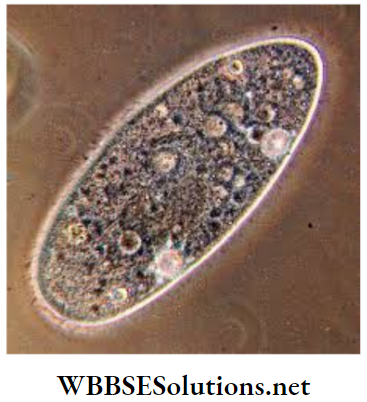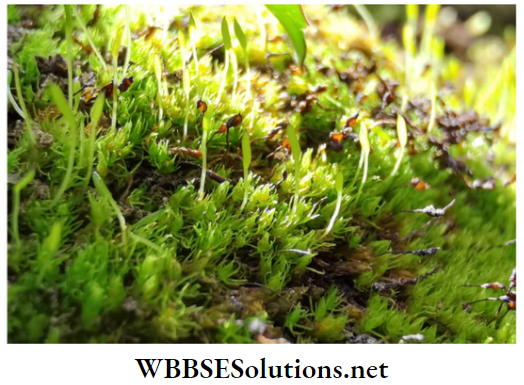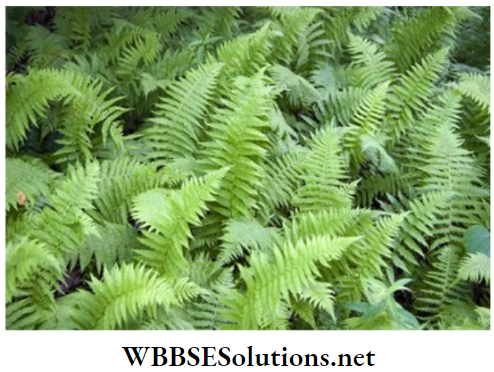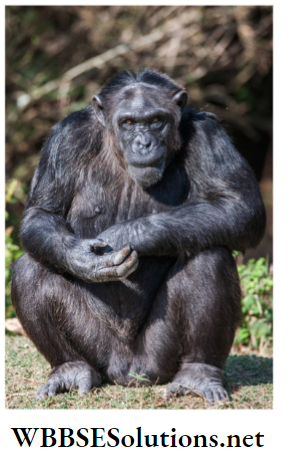Chapter 10 Biodiversity And Its Classification Introduction
The life forms originated on this Earth around 3.5 billion years ago from a simple unicellular bacteria-like organism from the water, but it gradually flourished with time, and at present, there are more than 3 crore life forms in this world.
Thus it is clear that living organisms are characterized by diversity.
Biodiversity (or Biological diversity) is defined as the variability among living organisms from all sources including terrestrial, marine, and other aquatic ecosystems and the ecological complexes of which they are part.
It includes genetic diversity, species diversity, and ecosystem diversity which together affect the complex ecological processes operating at different levels.
Read And Learn More: WBBSE Notes For Class 6 School Science
Amongst all the prevailing organisms in the world, the extent or degree of diversity is more in animals than in plants.
Since biodiversity plays an important role in ecosystem services, a need was felt to index, categorize and measure this complex organization.
Systematics is the study of diversity of organisms and classification is a part of the broader field of systematics.
Classification deals with the ordering or ranking of organisms into groups on the basis of similarities or closeness or relationship by listing the unique characters of each taxon (or taxonomic group which represents the real biological organisms included in a category).
Classification of organisms has come a long way from Linnaean two kingdoms to the presently accepted five-kingdom system as shown below
Chapter 10 Biodiversity And Its Classification Monera
- The unicellular prokaryotic organisms. which do not have true nuclei bound by a nuclear membrane.
- These organisms are the oldest organisms in this world.
- They can survive in extreme environmental conditions. Monera includes the following organisms.
Archebacteria:
- They are the oldest organisms in this world.
- They survive in extreme environmental conditions.
- They are anaerobic and are the ancestor of present-day organisms, for example, Methanogenic bacteria.
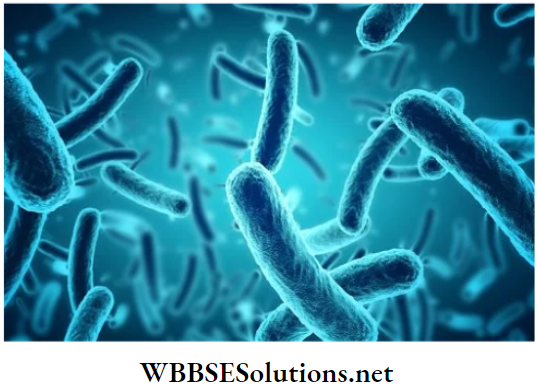
WBBSE Class 6 Biodiversity Notes
Eubacteria:
- These bacteria represent the largest group of prokaryotic organisms.
- They are classified on the basis of cell wall structure example Gram positive and Gram negative in nature.
- They are both aerobic and anaerobic in nature and can also be classified on the basis of nutrition, the presence or absence of flagella, for example, Mycobacterium, and Vibrio.
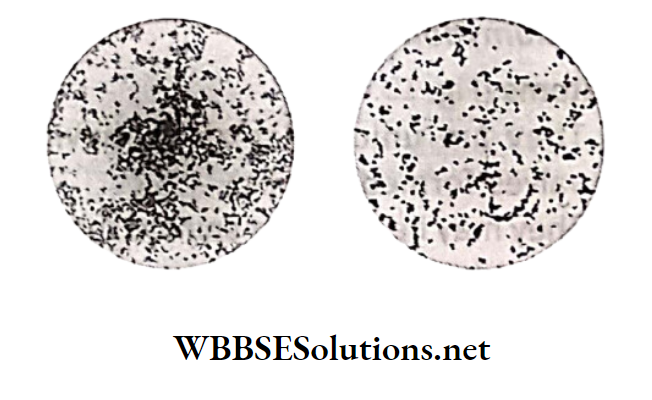
Cyanobacteria:
- They are blue-green in color due to the stun presence of unique pigments called chlorophyll-a and c-phycocyanin.
- They are without flagella, grow in water, and do not have true sexual reproduction.
- They have nitrogen-fixing ability and may be used as biofertilizers, for example Nostoc, and Anabaena.
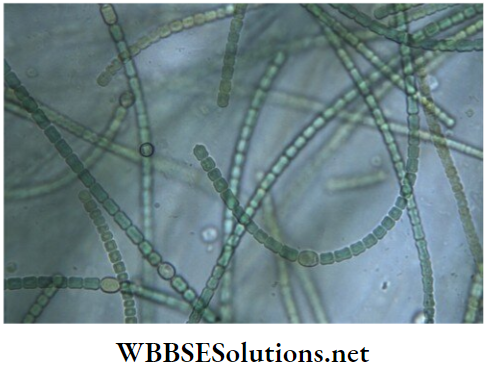
Mycoplasma :
1. They are bacteria-like organisms without any cell wall and so they are capable of slime changing their shape, also called Pleuronsdm Pneumonia Like Organisms (PPLO), for example, Mycoplasma.
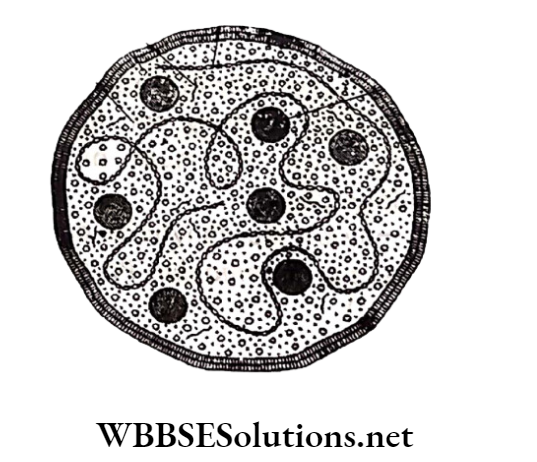
Chlamydia:
- This organism is an intermediate between viruses and living organisms.
- It does not have true cells and causes parrot fever, for example, Chlamydia.
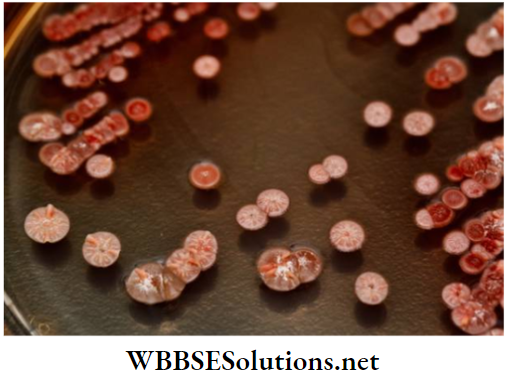
Actinomycetes:
- They are intermediate between fungi and bacteria.
- They are filamentous in nature and cut off thin-walled spores in chains.
- They are mostly soil-borne, and produce yes, antibiotics, for example, Streptomyces.
Chapter 10 Biodiversity And Its Classification Protista
This group of organisms includes unicellular eukaryotes. It may include plants, animals, and fungi. It is a mixed group and includes the following organisms:
Unicellular green algae :
- The unicellular green algae has a cellular wall and chloroplast and food remains stored in the pyrenoid.
- They may be with or without flagella, for example, Chlamydomonas.
Diatoms:
- They are unicellular algae, having two mo valves formed of silica.
- They may be round or spindle-shaped, for example, Pennularia.
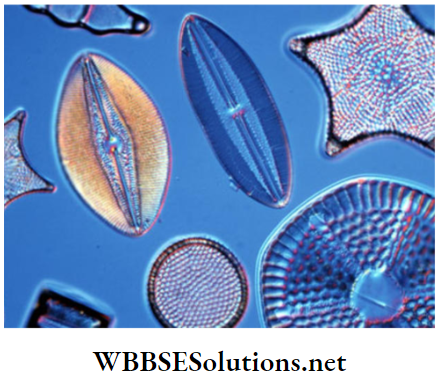
Myxomycetes:
- They are intermediate between fungi and protozoa.
- They have thread-like multi-nucleate structures and may be saprophytic or parasitic in nature, e.g. Plasmodiophora.
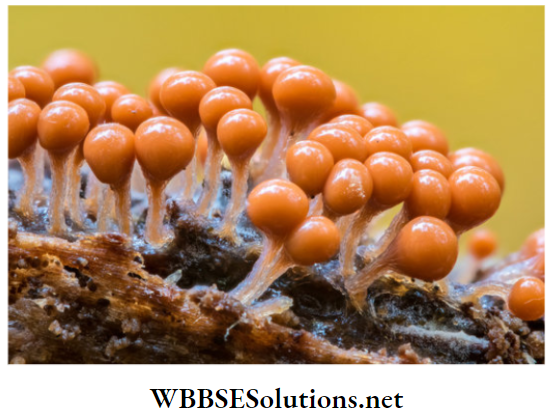
Understanding Biodiversity
Dinoflagellates:
- They are unicellular, formed of 2 valves with a central groove, and the two flagella are arranged in such a way that they are oriented at right angles.
- They cause red tide in the sea, for example, Dinoclonium.
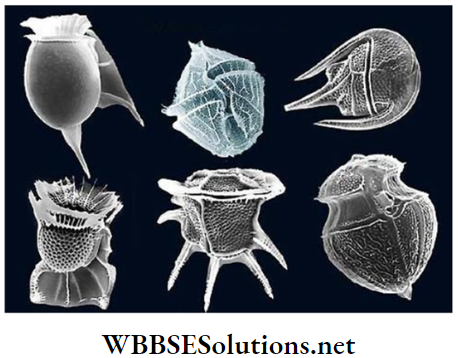
Protozoa :
- They are unicellular organisms similar to animal cells, having cell membranes, and moving with the help of cilia or pseudopodia.
- They may be saprophytic or parasitic in nature, for example, Entamoeba, and Paramoecium.
Chapter 10 Biodiversity And Its Classification Fungi
- They are unicellular or multicellular organisms without chlorophyll.
- They are capable of surviving saprophytically, parasitically, or symbiotically. The major groups are as follows
Zygomycetes:
They are filamentous organisms without septation, multinucleate, and reproduce asexually by sporangiospores and sexually by zygospores, e.g. Mucor.
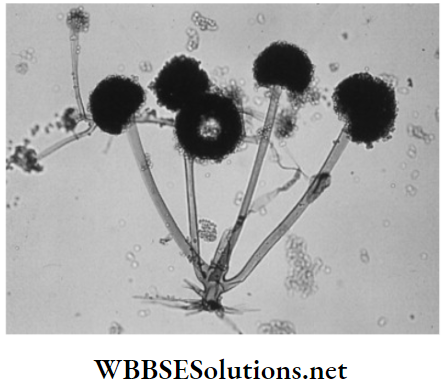
Oomycetes :
They are thalloid or unicellular in nature, ciliated in nature, and reproduce sexually by oospores and asexually by zoospores, for example, Phytophthora.
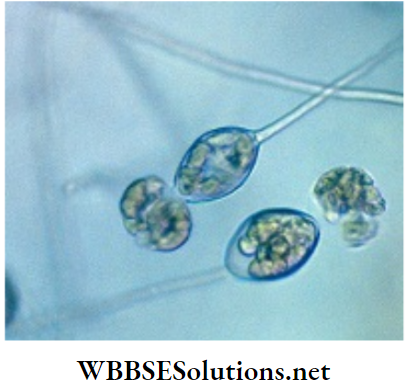
Ascomycetes:
- They are unicellular or filamentous in nature.
- They are having septate filament, which reproduces asexually by budding or fragmentation but reproduces sexually by ascus and ascospore, for example, Yeast and Penicillium.
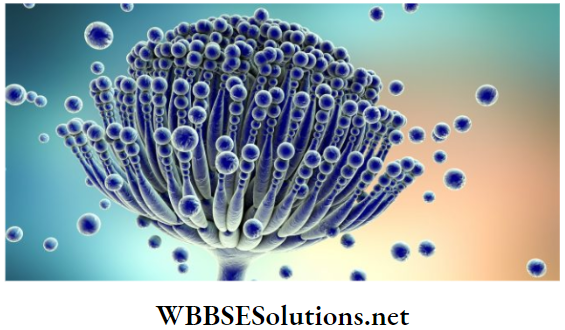
Basidiomycetes:
1. This group of fungi is with septate mycelia and reproduces sexually by basidia and basidiospore and the mycelia join with each other producing complex structures or fruit bodies, for example, Agaricus.
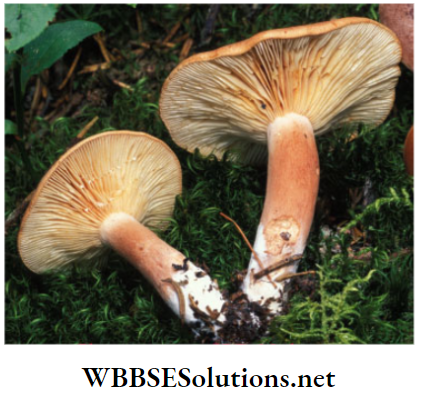
Deuteromycete:
1. They include a group of fungi without sexual reproduction, for example, Alternaria.
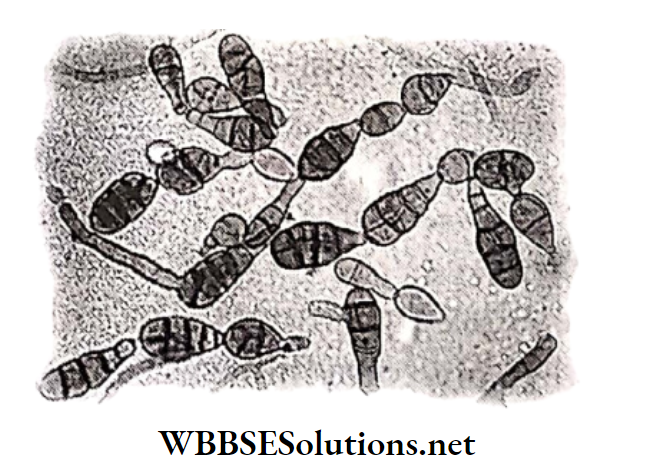
This group is very large and the major divisions are shown below:
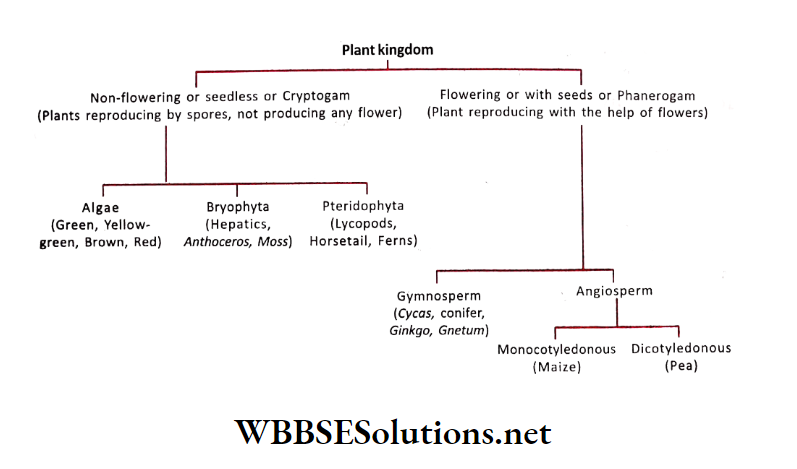
Chapter 10 Biodiversity And Its Classification Algae
1. They are aquatic plants with different types of chlorophyll pigments and other d accessory pigments.
Green Algae :
- The multicellular green algae may be colonial, filamentous, or true plant-like.
- They have chlorophyll-b with a complex structure and food is stored as carbohydrate and protein structures called Pyrenoids, for example, Spirogyra, and Chara.
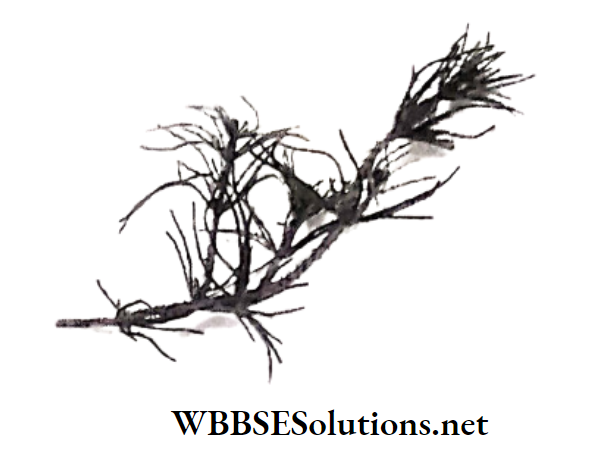
Yellow-green Algae:
The thalloid algae with green chlorophyll and yellow xanthophyll and they also store starch, Vaucheria.
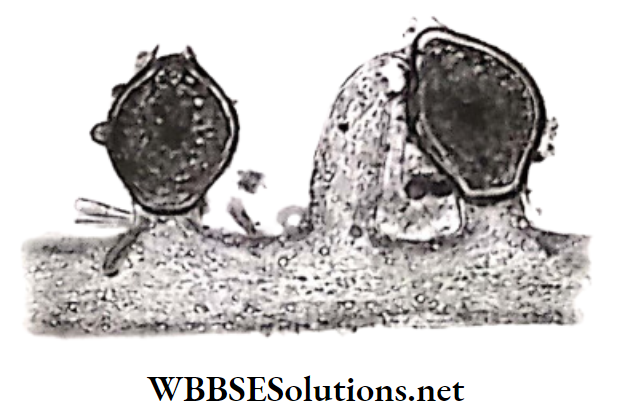
Important Definitions Related to Biodiversity
Brown Algae :
- The algae with a large plant body, well-differentiated into stems and leaves.
- They are exclusively marine.
- They have chlorophyll-c and brown pigment fucoxanthin. example Laminaria, Sargassum.
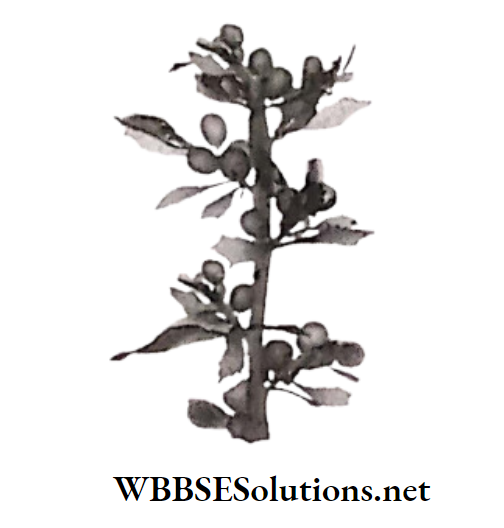
Red Algae :
- They have pigments like chlorophyll-e and r phycoerythrin.
- They are also well differentiated into root, stem, and leaves, the stem may have tubular conducting tissue.
- They may have a neutral polysaccharide as their stored food called agar, for example, Polysiphonia.
Chapter 10 Biodiversity And Its Classification Bryophytes
These plants are intermediate between terrestrial and aquatic conditions and that is why they are called amphibious plants.
Hepatics:
- These plants are thalloid in nature, growing along the surface of the soil.
- They are differentiated into basal storage zone and upper photosynthetic zone.
- They reproduce in the presence of water.
- They are so-called because the plant body looks like a liver, for example, Riccia).
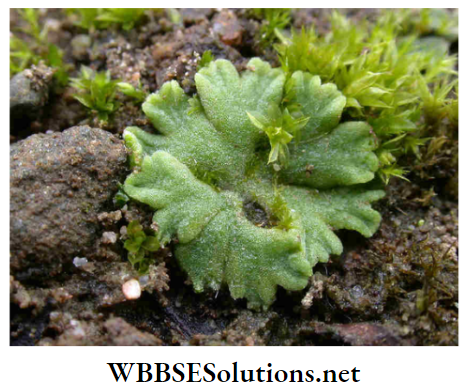
Anthocerotae :
- These plants are intermediate between sad villa thalloid and leafy structures.
- The plant body has a multi-tier and long horn-shaped spore-bearing structure called a capsule and so these plants are also called hornworts, for example, Anthoceros.
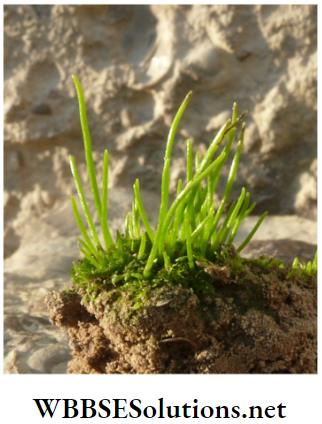
Moss :
- These plants are leafy bryophytes.
- They have well-differentiated root, stem, and leaves and a well-differentiated spore-bearing structure called a capsule.
- The spores have a specific mechanism of dispersal, for example, Pogonatum.
Chapter 10 Biodiversity And Its Classification Pteridophyte
- These plants are called vascular cryptogams because they have to conduct tissue in the form of xylem and phloem.
- They also exhibit an alternation of generational thank ann between the spore-bearing sporophyte zoom as
and the gamete-producing plant body. The major groups are as follows
Lycopods :
1. These plants have non-woody stems, scaly leaves, and cones or strobilus as their reproductive structure, for example, Lycopodium.
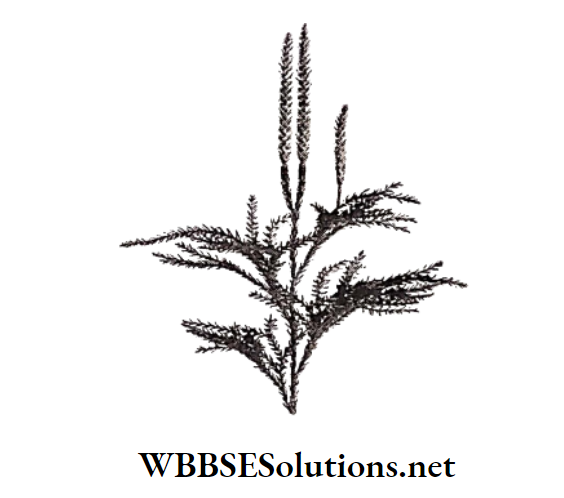
Horsetails :
- These plants are also called Sphenopsids and look like horsetails.
- They have silica in their cell wall giving mechanical support.
- The spore-bearing structure is a compact sporangiophore, for example, Equisetum.
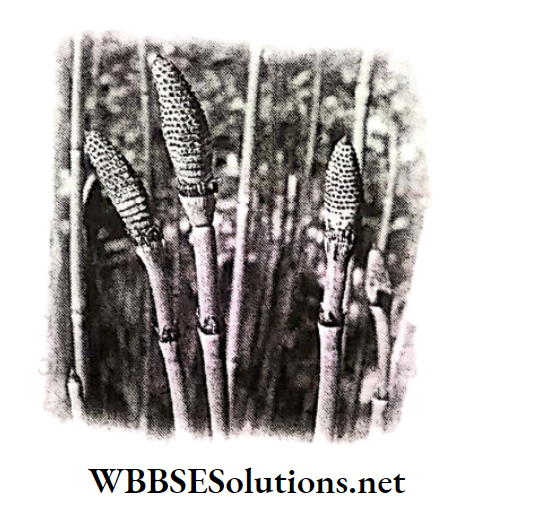
Ferns :
- They are the most developed plants among pteridophytes.
- The spore-bearing and gamete-bearing Vows plant bodies are distinctly different from each other.
- The leaves are compound in nature and they bear the spore-bearing structure or sporangia on the ventral surface of the leaf aggregated to produce the sorus.
- They are grown as ornamental plants, for example, Dryopteris.
Chapter 10 Biodiversity And Its Classification Gymnosperms
These plants are big woody trees that usually bear cones containing naked seeds. They include the following:
Cycas :
- The plant looks like a dwarf coconut tree, with a monopodial stem and apical crown of leaves.
- The roots are coralloid in nature heavily infected with blue-green algae, for example, Cycas.
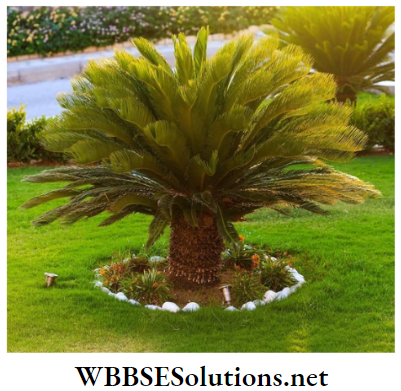
Conifer :
1. The trees are very large, the stem is woody, the leaves are spiny in nature, roots are infected with vesicular-arbuscular mycorrhizae, for example, Pinus.
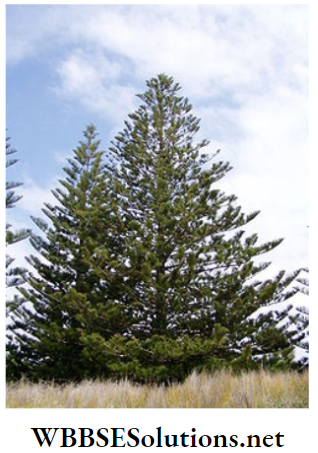
Ginkgo:
The plants are endemic to Korea and Japan, small and shrub-like, with male cones and female megasporophyll having a pair of ovules, for example, Ginkgo.
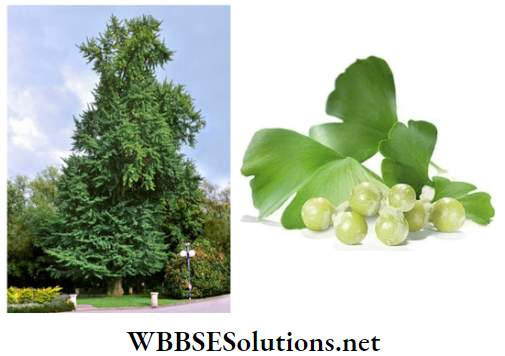
Gnetum:
- The plant is a small tree.
- It is the most developed gymnosperm, having large leaves, male and female. reproductive cupules containing stamens and ovules protected by perianth.
- They are considered intermediate. between gymnosperm and angiosperm, for example, Gnetum.
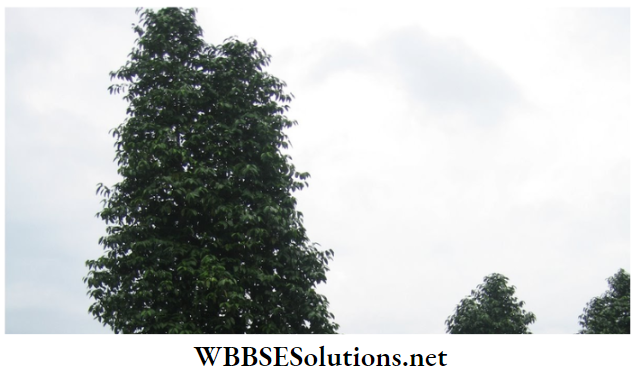
Chapter 10 Biodiversity And Its Classification Angiosperms
- They are flowering plants mainly divided into two major groups, Monocotyledonae having a single cotyledon and Dicotyledonae having 2 cotyledons.
- These plants are the largest at present in the world.
Monocotyledonous plants:
- These plants have mostly non-woody stems, sheathing leaf bases, parallel venation, and trimerous flowers.
- Single cotyledon in the seed.
- Seeds with endosperm, for example, Paddy
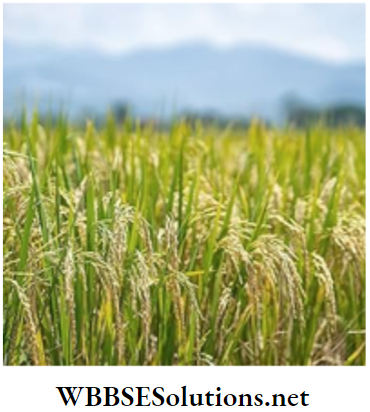
Dicotyledonous plants: These plants have:
- Woody stem with massive secondary unglad n wood.
- Distinct stalked leaves with reticulate venation.
- Pentamerous flowers.
- Seeds non-endospermic.
- Seeds with two cotyledons example Mango, Bengal gram.
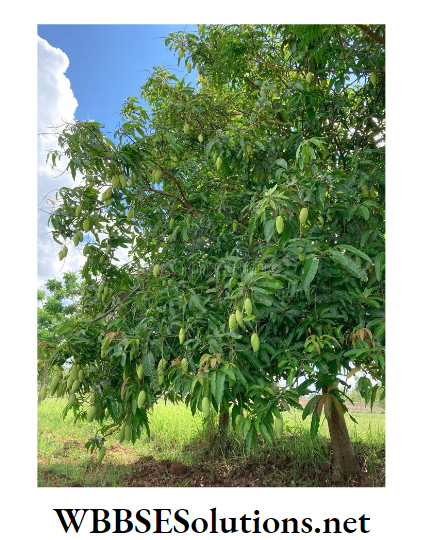
Leaf venation:
Leaf venation is the arrangement pattern of the veins on the leaf blade. Leaf venation is basically of two types.
1. Reticulate venation:
1. In this type, the veins branch and unite forming a complicated network. All the veins are interconnected, like the strands of the net. Leaves of Dicot plants generally have reticulate venation, for example, Hibiscus.
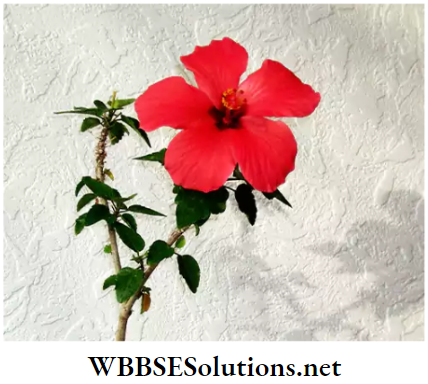
Real-Life Scenarios Involving Ecosystem Diversity
2. Parallel venation:
In this type, the veins run parallel or nearly parallel to each other and are connected by smaller veins. Leaves of Monocot plants generally have parallel venation, for example, banana, and wheat.
On the basis of nature and the size of stems, plants may be classified as Herbs, Shrubs, and Trees.
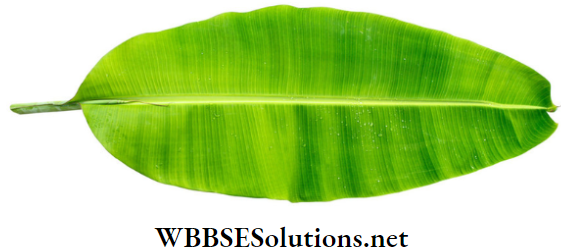
Herbs:
- The plants are short with almost no branches and soft stems.
- They are either creepers or climbers.
- They are short in height. example, Marigold.
Shrubs :
- The plants are woody but not too tall and have many branches and leaves.
- They look like bushes.
- They are of medium height, for example, china rose.
Trees:
- The plants are tall with strong stems.
- They have many branches and leaves, for example, mango.
Chapter 10 Biodiversity And Its Classification Animalia
The animal kingdom is very large with different multicellular organisms. Before going into classification, let us define and understand some terms connected with it.
1. Metazoa :
A group that comprises all animals having the body composed of cells differentiated into tissues and organs.
2. Eumetazoa :
It comprises all major animal groups except sponges and has truly organized tissues.
3. Acoelomata:
Animals have no coelom or body cavity.
4. Pseudocoelomata:
Animals have no true coelom but have a cavity in between the cuticle and visceral organs filled up with fluid.
5. Coelomata:
Animals have true coelom or body cavities lying in between the body wall and the alimentary canal.
6. Diploblastica:
Animals whose body is formed of ectoderm and endoderm cells only.
7. Triploblastica:
Animals whose body is formed of ectoderm, mesoderm, and endoderm cells.
These groups are discussed below:
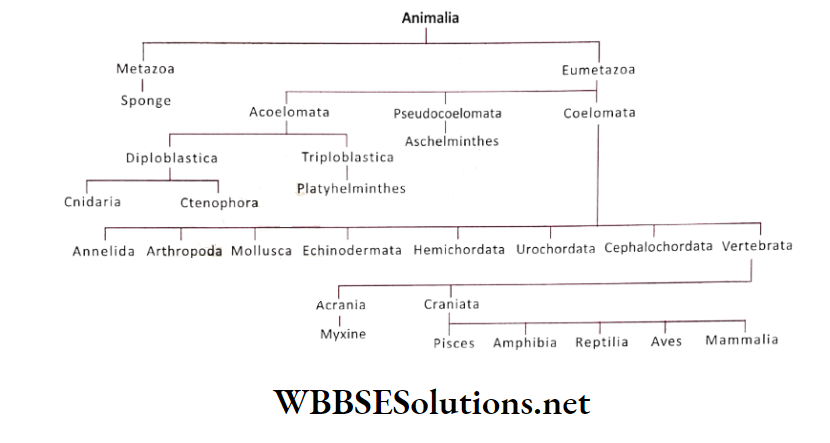
1. Invertebrate :
1. The animal has 2 layers.
Sponge:
- The animal is without the definite organization of tissues.
- They are sedentary in nature.
- The body is formed of a calcareous shell having multiple pores called ostia and an apical pore called osculum, for example, Sycon assumes.
Cnidaria:
- The animal is cylindrical in nature.
- It has two layers, ectoderm, and endoderm.
- The mouth is guarded by tentacles.
- They exhibit extracellular and intracellular digestion.
- The body consists of nematocysts, used for traping pray, for example, Hydra
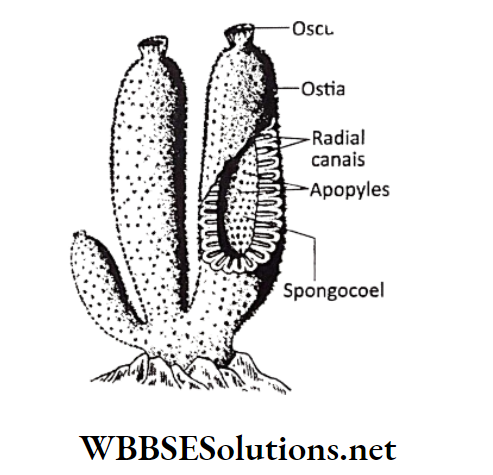
Ctenophora:
- The animal has 2 layers.
- It is marine.
- It has a locomotory organ in the form of comb plates and specialized cells for trapping prey called Suzaid business caul oblast cells, for example, Beroe.
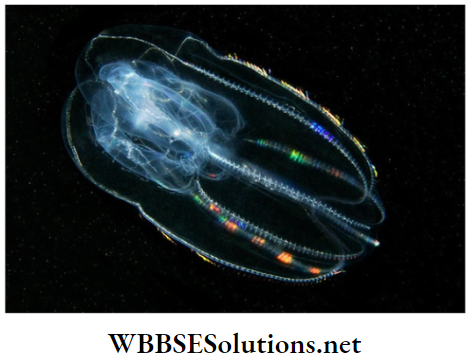
Platyhelminthes :
- The animal has a flattened body, the body is segmented.
- The animal is bisexual showing self-autumn fertilization, and survives as an endoparasite, for example, cedes to Taenia.
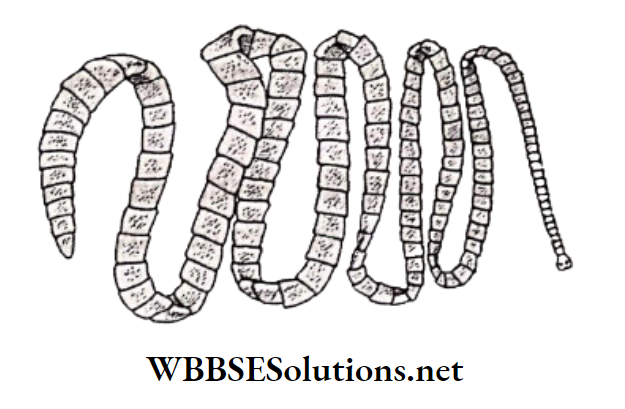
Aschelminthes :
- The animal is unisexual, having a pseudocolor.
- The female is larger than the male.
- They have a thick cuticle and survive as endoparasite, for example, Ascaris
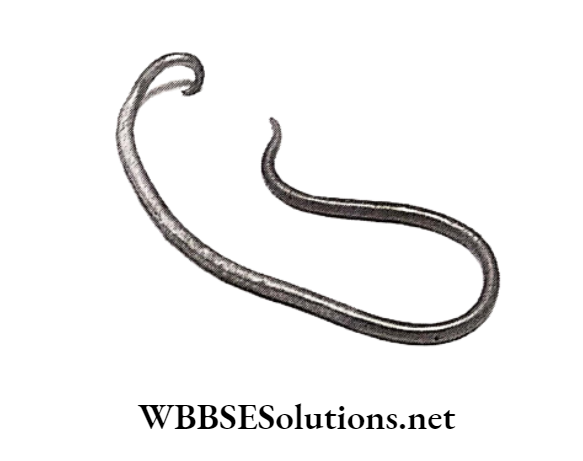
Annelida :
- The animal is cylindrical in nature, with metameric segmentation.
- The animal may have red pigment haemoglobin but it is in the plasma.
- The blood circulation is closed.
- The animal is bisexual but is not capable of showing self-fertilization, for example, Pheretima posthuma (earthworm)
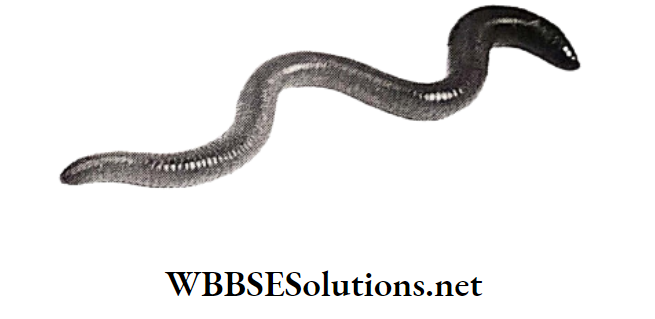
Arthropoda :
- This animal group is the largest having 4 sub-groups.
- They have open circulation with multi-chambered) sm heart.
- The sexes are different and fertilization is internal, example Periplaneta americana (cockroach)
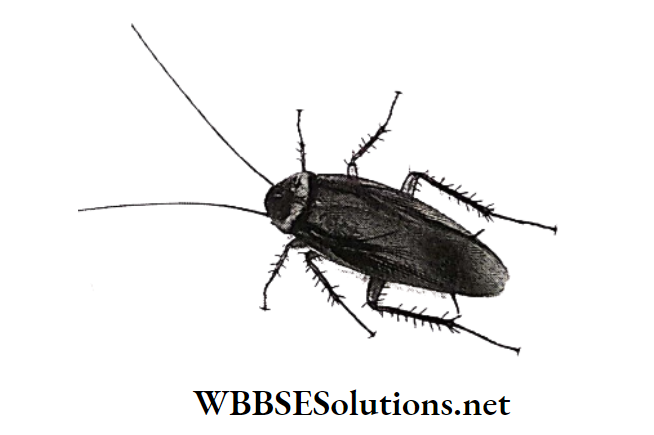
Mollusca:
- The animal has a soft body covered by the mantle and well protected calcareous shell.
- The sexes are different and are intermediate between open and closed circulation, for example, Pila
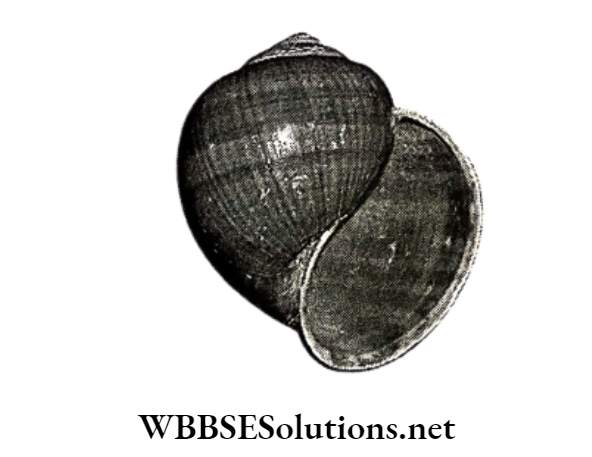
Echinodermata:
- The animal has a calcareous endoskeleton with projections.
- They have blood circulation and a water vascular system.
- They are marine and feed from the sea bed i.e. benthonic inhabit, for example, Asterias (Starfish).
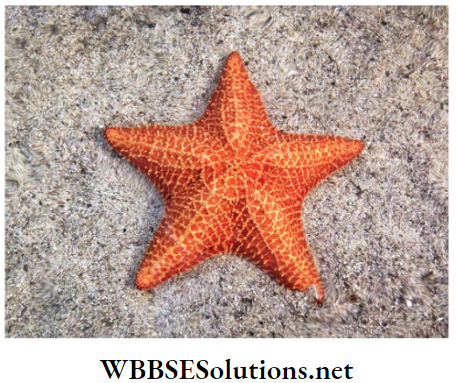
Hemichordata:
The animal is not under chordates, because they do not have notochord in the matured stage, for example, Balanoglossus.
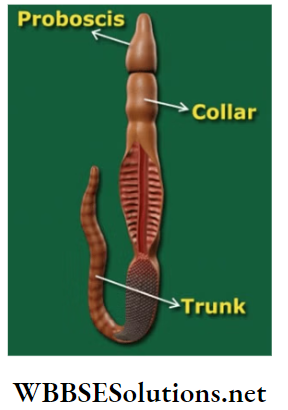
Urochordate:
- The notochord (an elastic rod-like structure situated immediately above the alimentary canal and covered by a sheath.) is limited to the tail region.
- The animal retains larval character in the adult stage and this phenomenon is called retrogressive metamorphosis example Ascidia
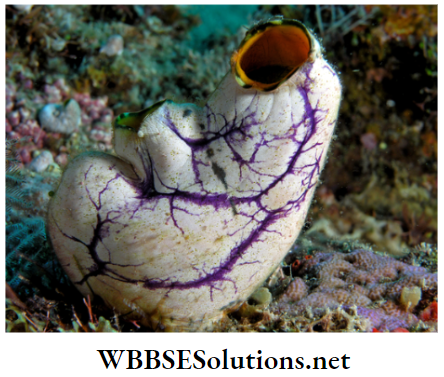
Cephalochordata:
- The animal has a notochord extended up to the head region.
- The animal has a tail fin and many characteristics as fish, for example, Amphioxus.
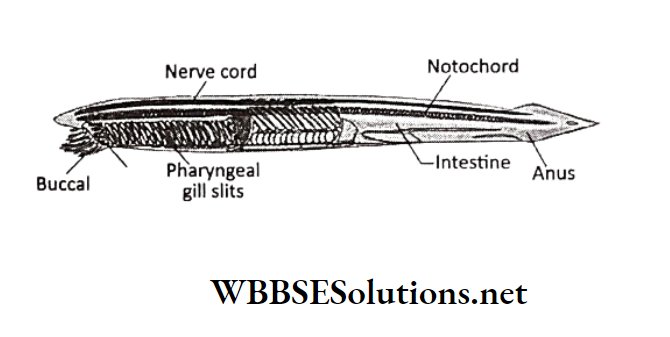
Vertebrate:
These animals have a backbone called a vertebral column enclosing and protecting the spinal cord.
Cyclostomes:
The animal has a circular mouth with sharp teeth, for example, Myxine.
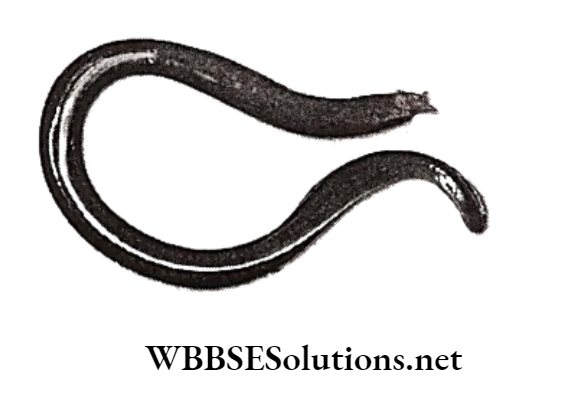
Pisces:
- The group includes all the fish.mat
- The fishes can be cartilaginous (chondrichthyans) or osteichthyan (bony fish), for example, sharks and Rohu.
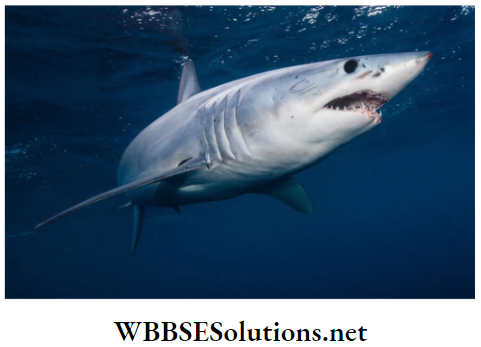
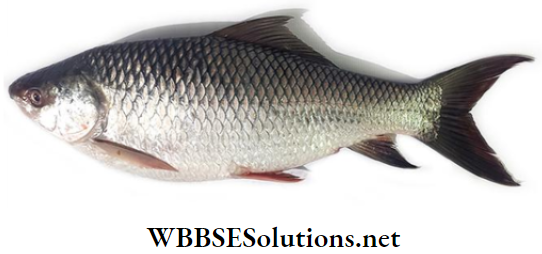
Amphibia:
- This group of animals survives both on land and water.
- They have 3 chambered hearts.
- They go into hibernation or winter sleep, for example, Frogs.
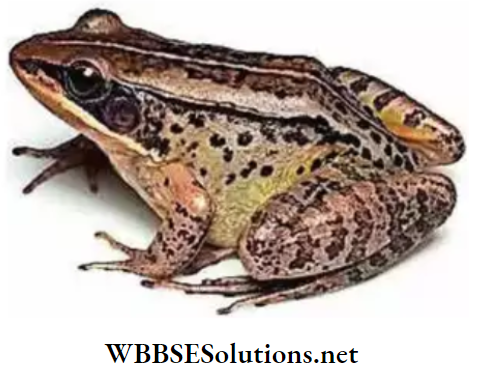
Reptiles:
- The animal has an external epidermis.
- The animal is terrestrial.
- The limbs have digited claws.
- The animal is cold-blooded
- The ventricle is partially segmented except in crocodiles, which have 4 chambered hearts, for example, Snakes.
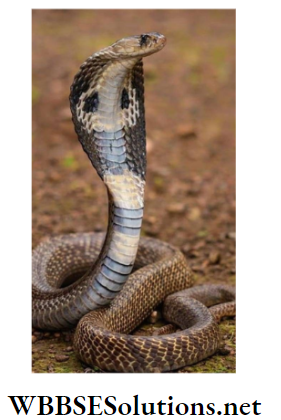
Aves:
- This group is represented by birds, which can be of 2 types, the running bird and the flying bird.
- They are warm-blooded.
- The heart is four-chambered.
- The body is covered with feathers, anterior pair of limbs are modified to produce wings.
- The lips are modified to produce toothless beaks, for example, Ostrich
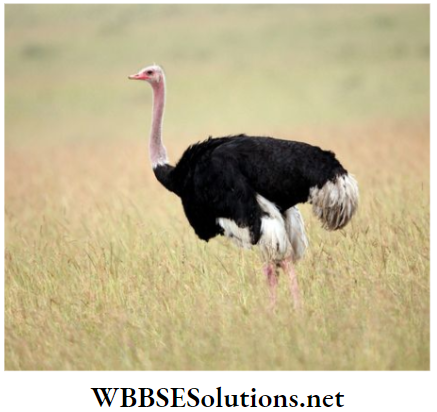
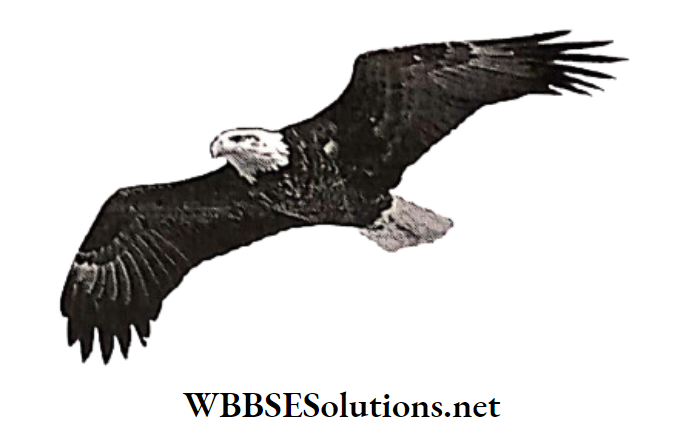
Mammals:
- The animal group is most advanced with the presence of external hairs, pair of external pinna (ear).
- The brain is developed that controls all the major functions, the two lobes of the forebrain function in a well-coordinated manner because they are joined by the Corpus callosum.
- The mammary gland is functional in females for providing nourishment to the developing ones.
- The most primitive mammals are egg-laying Platypi and myg but the intermediate forms have a pouch, which stores the developing babies called marsupium example Kangaroo.
While the most developed mammals are placental mammals, where the last developing fetus is provided with nourishment from the mother’s body through the placenta, for example, Human, Ape.
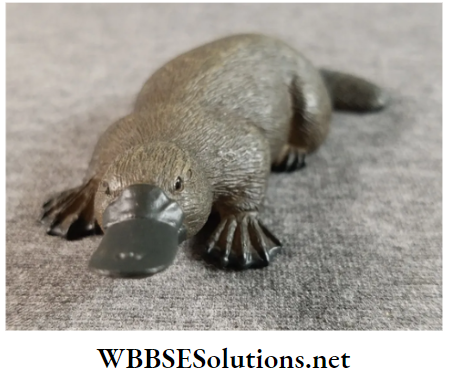
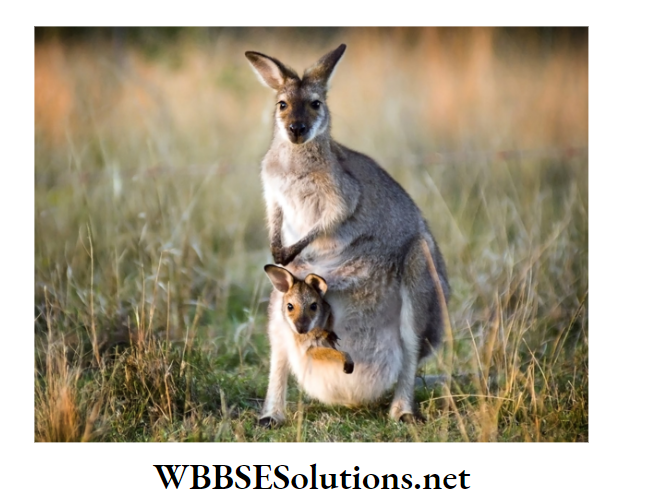
Chapter 10 Biodiversity And Its Classification Present Status Of Living Organisms In The World
The microbes are reproducing and developing at a very fast rate. If they are exposed to different types of antibiotics they develop resistance against these drugs.
Thus they impose an enormous threat to human beings in the future. The flora and fauna surviving in the present-day world are exposed to huge amounts of pollution caused by the human race.
They are endangered and will eventually become extinct in the long run.
If human-induced pollution is not reduced in this world, it will disturb the ecological balance and impose a serious threat to our existence by destroying the biodiversity of the planet.

